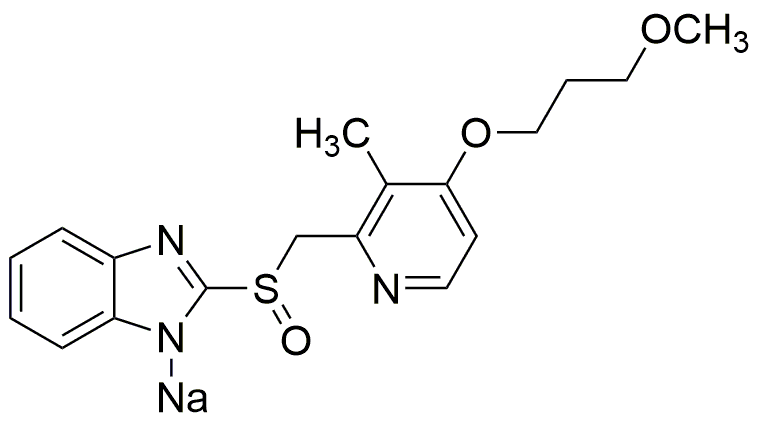Rabeprazole sodium salt is widely utilized in research focused on:
- Gastrointestinal Disorders: It is primarily used in the treatment of acid-related conditions such as gastroesophageal reflux disease (GERD) and peptic ulcers, providing effective relief from heartburn and discomfort.
- Pharmaceutical Development: Researchers leverage its properties to develop new formulations and delivery methods, enhancing the bioavailability and efficacy of proton pump inhibitors.
- Clinical Trials: Rabeprazole sodium salt is often a key component in clinical studies aimed at understanding its long-term effects and safety profile in various patient populations.
- Combination Therapies: It is frequently used in combination with antibiotics to treat Helicobacter pylori infections, showcasing its role in improving treatment outcomes for patients.
- Veterinary Medicine: This compound is also explored for its potential applications in veterinary practices, particularly for managing gastric issues in animals, thus expanding its utility beyond human medicine.
General Information
Properties
Safety and Regulations
Applications
Rabeprazole sodium salt is widely utilized in research focused on:
- Gastrointestinal Disorders: It is primarily used in the treatment of acid-related conditions such as gastroesophageal reflux disease (GERD) and peptic ulcers, providing effective relief from heartburn and discomfort.
- Pharmaceutical Development: Researchers leverage its properties to develop new formulations and delivery methods, enhancing the bioavailability and efficacy of proton pump inhibitors.
- Clinical Trials: Rabeprazole sodium salt is often a key component in clinical studies aimed at understanding its long-term effects and safety profile in various patient populations.
- Combination Therapies: It is frequently used in combination with antibiotics to treat Helicobacter pylori infections, showcasing its role in improving treatment outcomes for patients.
- Veterinary Medicine: This compound is also explored for its potential applications in veterinary practices, particularly for managing gastric issues in animals, thus expanding its utility beyond human medicine.
Documents
Safety Data Sheets (SDS)
The SDS provides comprehensive safety information on handling, storage, and disposal of the product.
Product Specification (PS)
The PS provides a comprehensive breakdown of the product’s properties, including chemical composition, physical state, purity, and storage requirements. It also details acceptable quality ranges and the product's intended applications.
Certificates of Analysis (COA)
Search for Certificates of Analysis (COA) by entering the products Lot Number. Lot and Batch Numbers can be found on a product’s label following the words ‘Lot’ or ‘Batch’.
*Catalog Number
*Lot Number
Certificates Of Origin (COO)
This COO confirms the country where the product was manufactured, and also details the materials and components used in it and whether it is derived from natural, synthetic, or other specific sources. This certificate may be required for customs, trade, and regulatory compliance.
*Catalog Number
*Lot Number
Safety Data Sheets (SDS)
The SDS provides comprehensive safety information on handling, storage, and disposal of the product.
DownloadProduct Specification (PS)
The PS provides a comprehensive breakdown of the product’s properties, including chemical composition, physical state, purity, and storage requirements. It also details acceptable quality ranges and the product's intended applications.
DownloadCertificates of Analysis (COA)
Search for Certificates of Analysis (COA) by entering the products Lot Number. Lot and Batch Numbers can be found on a product’s label following the words ‘Lot’ or ‘Batch’.
*Catalog Number
*Lot Number
Certificates Of Origin (COO)
This COO confirms the country where the product was manufactured, and also details the materials and components used in it and whether it is derived from natural, synthetic, or other specific sources. This certificate may be required for customs, trade, and regulatory compliance.


